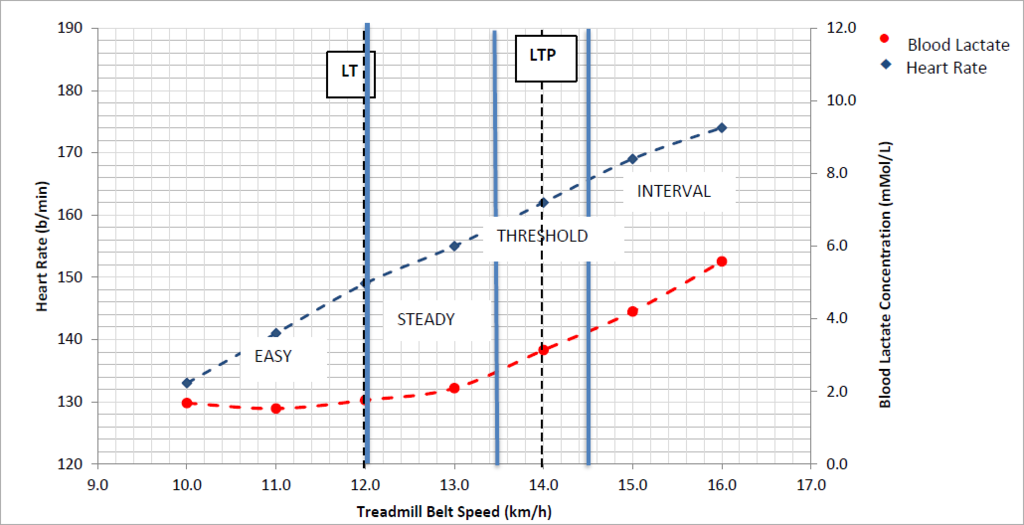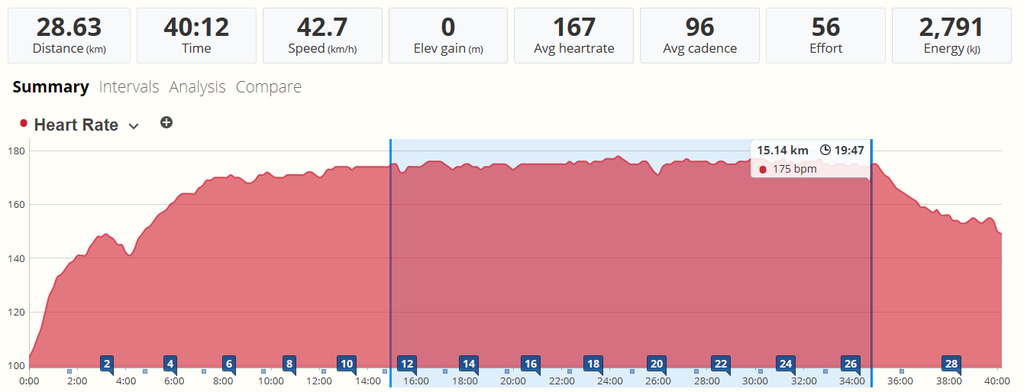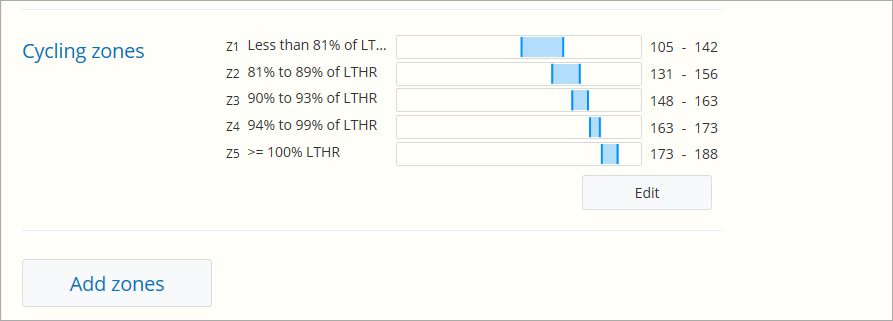Determine Your Lactate Threshold
Put in your best effort with zone training based on your LTHR
I am asked yet again how to find one's lactate threshold heart rate (LTHR) by doing a 30-minute time trial. I really don't understand what seems to be so difficult about this.
—Joe Friel, renowned triathlon coach, 2011
A bit of lactate theory
The benefits of zone-based training are many and varied; but if your zones are inaccurate — the benefits may not be realized.
Heart rate training zones are usually set arbitrarily, based on a supposed “maximum” rate. However, if you go through the trouble of determining your own LTHR, you can construct more accurate zones.
The LTHR is the point, above which, increased blood acidification occurs in your body. Crossing this threshold will make your endurance performance rapidly decrease. In a race, you might maintain that level for up to an hour, but at a certain point you will slow down. When the lactate clears from your system, you can pick up the pace again, but the point is to avoid slowing down altogether.
Blood samples taken during laboratory treadmill tests will determine your LTHR, as shown:

The Lactate Threshold is sometimes referred to as the first turning point (LT on the above graph), however, you need to know when a sustained rise occurs, which is the Lactate Turning Point (LTP on the graph — LTP is the same thing as LTHR). This an important metric for an athlete to be aware of. It gives you a good understanding of what your maximum exertion can be, without going overboard and slowing down. It enables you to put in your best effort on race day.
On the above chart, the LTHR occurred at 14.0km/h and this corresponds to 162bpm. For those of you who are familiar with heart rate training zones, this is approximately the boundary between Zone 4 and Zone 5.
How can I determine my LTHR?
The first problem is that you probably don’t have a fully-equipped scientific sports laboratory in your basement. Then you realize that you probably have a different LTHR for each sport, and the expense of being tested professionally would add up. You might also be concerned that fatigue, caffeine or other supplements will affect your LTHR. And, on top of all of that, you have a different training regime leading up to, and on race day.
Instead of determining your LTHR in a lab, you can estimate it based on a 30 minute test. (30 minutes is widely thought to provide a good estimate.) Keep in mind that a heart rate monitor is required to conduct this test.
Step 1:
Find a flat, uninterrupted course to either run or bike on. A bicycle trainer or a treadmill are acceptable to use as well, as they exclude opportunities to be restricted by traffic, traffic lights, hills, or wind.
Step 2:
Go as fast as you can for 30 minutes, but be sure to press the Lap button on your tracking device at the 10 minute mark, and press Stop at 30 minutes. The average heart rate from the last 20 minutes will be used to estimate your LTHR.
As you can see, the test is straightforward. I wouldn't say it’s simple — because you need to exert maximum effort the entire time. At the end of the test you should be exhausted. If you do it wrong, you will be fatigued and probably not be able to redo the test for a few days, in order to get accurate results.
Performance tips
You can look at the data from previous efforts to help regulate your exertion during the 30 minute test. Look at your last 10k run or your last 10 mile TT (Time Trial), and target the average HR for the last 20 minutes of each. The former race is longer than 30 minutes, the last probably quite a bit shorter. The TT is more likely to give a higher HR than you will be able to sustain in your test, and the 10k run should be close to your LTHR.
Test for each sport
With Garmin's July 2015 announcement of the HRM-SWIM heart rate monitor, all three main sports watch manufacturers (Suunto, Polar, and Garmin) now support the recording of heart rate whilst swimming. This is great, because different sports use different muscle groups. You are likely to have very different levels of conditioning in each sport, and different LTHRs. For example, my LTHR for running is 3bpm higher than it is for cycling, and 7bpm higher than it is for swimming.
Is a 30 minute test really accurate?
Sort of. In my experience, there are many factors that cause errors. Even lab tests have discrepancies, such as: your motivation, fatigue level, caffeine intake, the temperature, etc. My first lab test showed a result that was 5bpm lower than what I found in the 30 minute test. That’s a significant difference.
Is it useful?
Yes. The structure that’s imposed when you train by zones can help you significantly. You can also use “Pace Zones,” “Power Zones,” and zones based on “Perceived Effort.”
Will it remain accurate?
No. As you get more in shape, your LTHR should increase. Re-testing every six weeks or so is a good idea to both determine your improvement and refine your training zones.
Here's a recent 30 minute bike test with the key 20 minute period of heart rate data highlighted. You can see the average HR shown as 175bpm. This is the LTHR. SportTracks makes finding these averages easy.

When you hit the Lap button at 10 minutes and again at 30 minutes, you'll also see the HR displayed in the "Segments" tab in SportTracks. You can then set your HR zones for each sport in your SportTracks profile. Shown below is the 175bpm LTHR transferred to manual HR Zones and the option is given by SportTracks to apply these zones to historical data.

Once you have the same settings on your training watch, you can monitor your training as you exercise. Afterwards, you can review your training in SportTracks to ensure that you are spending the right amount of time in the right zones for your target race, and you can perform many other more complex analyses.
Train with purpose. Train with zones.
Other resources:
This basic spreadsheet calculates your zones and tells you what happens in each zone from a benefits and physiological perspective: http://the5krunner.com/2015/03/02/hr-power-training-zones-running-cycling-swimming-triathlon-spreadsheet/
This fantastic running spreadsheet will keep you LTHR and stat-happy for many, many hours: http://www.electricblues.com/html/runpro.html
This was a guest post by The5kRunner, an avid SportTracks user who regularly writes about all aspects of triathlon, duathlon, 5k running and the gadgets we love.

Comments
Is there a recommended warm-up for this 30 minute test, or do you just go out and start running as fast as you can for 30 minutes?
I've wondered the same. Logically starting cold is ill-advised because of risk of injury, but presumably warming up could skew the results. Any skew to HR might not be too significant, since it should be pretty stable during the last 20 mins. I think it could have more impact on LTHR pace (which I understand is the avg pace for the full 30 mins), depending on how much base mileage the runner has. Someone who is used to running 3 - 8k might be significantly impacted by a warm-up relative to someone who typically runs 8-12k. In the past, I've done a low intensity dynamic warm-up with stretching before this test and then waited a few mins to let my HR come back down. I tend to run longer, so am leaning toward a super-easy 15 min jog followed by HR recovery before my next test. Interested to hear the author's thoughts.
The warmup needs to be separate from the first 10 minutes of the test. The first 10 mintues of the test must be the same pace and intensity as the final 20 minutes of the test. The test is a 30-minute all-out effort, not a 20-minute all-out effort. Going different speeds during the first 10 minutes of the test will yield an inaccurate result.
You can warmup before the 30 minute portion of the test. The warmup can be 5 mintues, 10 minutes, whatever you feel you need. However, once you start the test, you need to maintain the same pace for the entire duration of the test.
Thank you for the clarification.
Could I also use the data of a half marathon? If I take the final 20 minutes my average is about 185, and total average is 178, but this seems like an awfully high LTHR. Max HR is ~194...